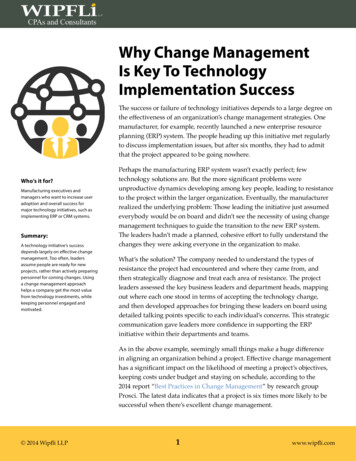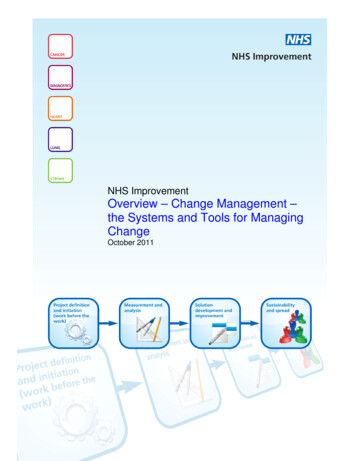
Transcription
Why Change ManagementIs Key To TechnologyImplementation SuccessThe success or failure of technology initiatives depends to a large degree onthe effectiveness of an organization’s change management strategies. Onemanufacturer, for example, recently launched a new enterprise resourceplanning (ERP) system. The people heading up this initiative met regularlyto discuss implementation issues, but after six months, they had to admitthat the project appeared to be going nowhere.Who’s it for?Manufacturing executives andmanagers who want to increase useradoption and overall success formajor technology initiatives, such asimplementing ERP or CRM systems.Summary:A technology initiative’s successdepends largely on effective changemanagement. Too often, leadersassume people are ready for newprojects, rather than actively preparingpersonnel for coming changes. Usinga change management approachhelps a company get the most valuefrom technology investments, whilekeeping personnel engaged andmotivated.Perhaps the manufacturing ERP system wasn’t exactly perfect; fewtechnology solutions are. But the more significant problems wereunproductive dynamics developing among key people, leading to resistanceto the project within the larger organization. Eventually, the manufacturerrealized the underlying problem: Those leading the initiative just assumedeverybody would be on board and didn’t see the necessity of using changemanagement techniques to guide the transition to the new ERP system.The leaders hadn’t made a planned, cohesive effort to fully understand thechanges they were asking everyone in the organization to make.What’s the solution? The company needed to understand the types ofresistance the project had encountered and where they came from, andthen strategically diagnose and treat each area of resistance. The projectleaders assessed the key business leaders and department heads, mappingout where each one stood in terms of accepting the technology change,and then developed approaches for bringing these leaders on board usingdetailed talking points specific to each individual’s concerns. This strategiccommunication gave leaders more confidence in supporting the ERPinitiative within their departments and teams.As in the above example, seemingly small things make a huge differencein aligning an organization behind a project. Effective change managementhas a significant impact on the likelihood of meeting a project’s objectives,keeping costs under budget and staying on schedule, according to the2014 report “Best Practices in Change Management” by research groupProsci. The latest data indicates that a project is six times more likely to besuccessful when there’s excellent change management. 2014 Wipfli LLP1www.wipfli.com
Why Change Management Is Key To Technology Implementation SuccessHow are manufacturers creating change management plans that workhand-in-hand with technology implementations to increase user adoptionand overall success? While many companies already have a formal projectmanager coordinating efforts, these people often find greater success byinterweaving change management and project management.Understanding Change ManagementPeople tend to think of change management as “good communication,”but that’s only the beginning. While good communication is important inspreading information about the change, it shouldn’t be mistaken for thechange process itself.The Association of Change Management Professionals, an internationalorganization, defines the practice as “a deliberate set of activities thatfacilitate and support the success of individual and organizational changeand the realization of its intended business results”.In practice, these activities often begin with assessing an organization’sculture and dynamics, through interviews, focus groups or surveys, andgathering information on past change initiatives to see which tactics workedand which didn’t.A company’s historical track record with change, for instance, is a keypredictor of future success with technology initiatives. Unfortunately, seniorleadership often underestimates the lasting effects that failed or unpleasantpast initiatives have on front-line staff. If these front-line system users havegood reason for cynicism and resistance, that past creates a huge hurdle toovercome. These users need to be in the right frame of mind before they’reready to embrace new technologies and processes, because they’re typicallythe most affected by these changes.Rather than an organization’s leadership assuming that the new project isgoing to somehow turn out better this time, change management activelyprepares personnel for coming changes.In this people-centered approach, a change management strategist suggeststhe most effective tactics to guide change, weaving these activities inalongside more traditional project management activities. These tacticsinclude explaining what’s going to be different for each type of employee 2014 Wipfli LLP2www.wipfli.com
Why Change Management Is Key To Technology Implementation Successor group, including personnel in the process, and taking time to listento and understand their concerns. All of these ultimately lead to peopleunderstanding the change and embracing it.Why Change Management Is Vital To Technology InitiativesCompanies often use change management methods when projects arecomplex and have a significant impact on the company and a large numberof people, and also when buy-in and user adoption are key to overall projectsuccess, according to Prosci’s best practices report. Those factors certainlydescribe large technology initiatives, such as implementing a manufacturingERP system or CRM software.Investing in these technology projects is typically expensive. And nomatter how well-designed and necessary the new tools are, the fact is that ifenough people resist using them, they soon become useless. With a changemanagement approach to user adoption, the organization, not simply thebusiness leaders, need to feel ownership of the project.Think about it in the context of education. If a teacher simply tells you whatto do and gives you all of the right answers, that’s not a recipe for learning.Part of learning and solving problems is feeling ownership of the solutionand having a role in discovering it.The same principle applies to learning and changing in a business setting.Everyone in an organization has personal pride at stake and believes inwhat they have to contribute. If decisions about new technology come acrossas authoritarian decrees, the natural reaction is to rebel, either in outrightsabotage or through subtle resistance.That’s why it’s important to begin incorporating a change managementcomponent as soon as you decide to invest in new technology. Don’t waituntil after you’ve identified the technical requirements and selected asystem before you start thinking about user adoption. Take the time toassess the different stakeholder groups and understand which facets of theorganization are most likely to have difficulty with the initiative. Identifythe people most likely to be early adopters and those most likely to resist,and plan how to reach those groups. 2014 Wipfli LLP3www.wipfli.com
Why Change Management Is Key To Technology Implementation SuccessMajor Obstacles and Success FactorsHere are five major obstacles organizations encounter when introducingsignificant change, according to the Prosci report:1. Lack of effective sponsorship in change management2. Employee resistance3. Insufficient resources for change management4. Failure to integrate change and project management5. Resistance from middle managementThe top five contributors to a successful project, such as a technologyinitiative, are:1. Executive sponsors in active, visible roles2. Change management structure in place3. Resources and funds dedicated for change management4. Frequent, transparent communication about coming changes andbusiness rationale5. Participation from employeesBringing change management in early as part of these projects makes goodsense for an organization’s interpersonal dynamics — and its bottom line.Going through the process keeps the different stakeholders engaged andultimately more receptive, even if they don’t necessarily agree with some ofthe decisions. And there’s hard data that supports the effectiveness of thisstrategic approach over the old way of doing things.For instance, Prosci’s best practices report draws on eight benchmarkingstudies, conducted between 1998 and 2013, and concludes that the quality ofa project’s change management strongly correlates with its ability to meetobjectives, stay on schedule and remain on budget.Projects with poor or fair change management met or exceeded objectivesless than half of the time — 16 percent for poor management, 46 percent forfair. Projects with good change management met or exceeded these goals77 percent of the time, and those with excellent management achieved a96 percent success rate — six times higher than those projects with poormanagement. 2014 Wipfli LLP4www.wipfli.com
Why Change Management Is Key To Technology Implementation SuccessMaximizing Your Organization’s Change CapacityAt the end of the day, it’s important to understand that people only have somuch capacity for change at any given time. Major technology initiatives,like implementing manufacturing CRM software, don’t unfold in a vacuum.Different departments and functions in your organization may already beconfronting challenging transitions in other areas.The role of change management, in a sense, is to assess and address thesedifferences, and to avoid overwhelming individuals while maximizing theorganization’s change capacity. Adopting this approach helps a companyget the most value from its technology investments, while also keepingpersonnel engaged and motivated.Think others may be interested? Share this white paper: 2014 Wipfli LLP5www.wipfli.com
significant change, according to the Prosci report: 1. Lack of effective sponsorship in change management 2. Employee resistance 3. Insufficient resources for change management 4. Failure to integrate change and project management 5. Resistance from middle management The top five contributors to a successful project, such as a technology .
![Change Management Process For [Project Name] - West Virginia](/img/32/change-20management-20process-2003-2022-202012.jpg)









